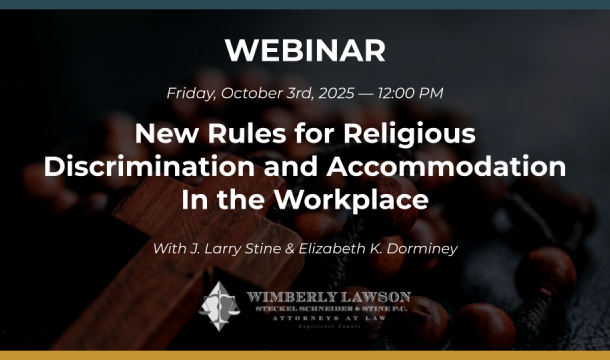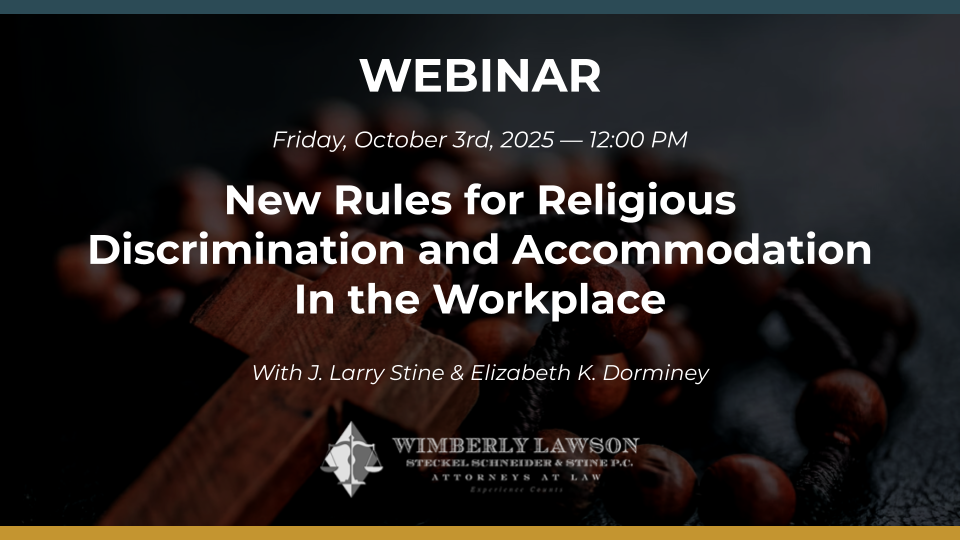SUPREME COURT SAYS JURY ISSUE CREATED WHEN EMPLOYER FAILS TO PROVIDE LIGHT DUTY TO PREGNANT WORKERS
Employers may be required to provide light duty to pregnant workers because of the U.S. Supreme Court decision in Young v. United Parcel Service, Inc., No. 12-1226. In the course of her duties as a driver, the plaintiff regularly lifted and moved packages weighing over 20 pounds and up to 70 pounds. She became pregnant and her healthcare providers recommended that she should not lift more than 20 pounds. When she sought to return to work, the UPS occupational health manager explained how UPS's then-applicable policy did not allow her to provide plaintiff with a "light duty" assignment.
The collective bargaining agreement specifies that UPS may make alternative assignments available to four categories of workers. UPS provides temporary alternative work assignments, if available, to employees who are unable to perform their regular jobs because of injuries sustained on the job. UPS designs these "work hardening" assignments to help those injured on the job rebuild their muscles so that they will no longer have weight restrictions and therefore can resume their normal job responsibilities as soon as possible. Second, the Americans with Disabilities Act (ADA) requires UPS to provide reasonable accommodations for an employee who has a cognizable impairment. Third, UPS will provide an "inside" job to drivers who lose their Department of Transportation (DOT) certification because of a failed medical examination, revoked or suspended driver's license, or involvement in a motor vehicle accident. Fourth, a provision specifically deals with maternity issues where required by applicable law in light of legislation in some states requiring employers to provide light duty work to pregnant employees. Otherwise light duty work assignments were not available to any employees who are unable to perform their normal work assignment due to lifting restrictions or other physical conditions that did not fall within one of the four categories of accommodations.
The plaintiff filed an EEOC charge alleging that UPS's denial of the requested light duty work accommodation constituted sex discrimination. She later sued under Title VII, as amended by the Pregnancy Discrimination Act (PDA). The PDA contains an express provision defining sex discrimination to include discrimination "because of . . . pregnancy" and clarifies that "women affected by pregnancy . . . shall be treated the same for all employment-related purposes . . . as other persons not so affected but similar in their ability or inability to work."
The federal district court ruled in favor of UPS on the basis that the undisputed evidence revealed that plaintiff had not shown direct evidence of discrimination; failed to establish a prima facie case of disparate treatment because she could not identify a similarly situated comparator who received more favorable treatment; she could not show that UPS's non-discriminatory application of a neutral policy was a mere pretext for discrimination. The Fourth Circuit Board of Appeals unanimously agreed, explaining that each of the federal court circuits that have considered the issue had held that an employer does not violate the PDA by denying a pregnant employee an accommodation or benefit pursuant to a pregnancy-blind policy like UPS's.
When the case reached the U.S. Supreme Court, it took an interesting twist in that the Department of Justice filed an amicus brief on behalf of the plaintiff. The significance of this is that DOJ had recently successfully defended a virtually identical policy utilized by the U.S. Postal Service, calling the plaintiff's position in that case "frivolous." During the oral argument before the Supreme Court, the DOJ attorney was asked why it was attacking a policy it had defended in the U.S. Postal Service case, and which the U.S. Postal Service was still currently using. He based the DOJ's change in position on the EEOC guidance that was issued during 2014.
The Supreme Court issued its ruling on March 25, 2015, setting forth a new standard different from the positions taken by both the plaintiff and the defendant. The Court first rejects the plaintiff's approach that once the employer provides one or two workers with an accommodation for some type impairment, regardless of the justification, then it must provide similar accommodations to all pregnant workers, irrespective of the nature of their jobs, the employer's need to keep them working, their ages, or any other criteria. The Court calls this approach giving pregnant workers a "most-favored-nation" status, which the Court expressly rejects. It states that this was not what Congress intended, and that the law normally permits an employer to implement policies that are not intended to harm members of a protected class, even if their implementations sometimes harm those members, as long as the employer has legitimate, nondiscriminatory, nonpretextual reasons for doing so.
However, the Court goes on to reject the defendant's position that the pregnancy discrimination amendments were only intended to add pregnancy to the definition of sex discrimination prohibited by Title VII. The Court states that Congress intended to do more than that.
The Court adopts a standard instead that a plaintiff alleging that the denial of accommodation constitutes disparate treatment under the pregnancy law may make out a prima facie showing, as in the McDonnell Douglas precedent, that she belongs to the protected class, that she sought accommodation, that the employer did not accommodate her, and that the employer did accommodate others "similar in their ability or inability to work." The employer may then seek to justify its refusal to accommodate the plaintiff by relying on "legitimate, nondiscriminatory" reasons for denying her accommodation. If the employer offers an apparent legitimate, nondiscriminatory reason, the plaintiff may in turn show that the employer's proffered reasons are in fact pretextual. The Court believes that the plaintiff may reach a jury on this issue by providing sufficient evidence that the employer's policies imposes a significant burden on pregnant workers, and that the employer's "legitimate, nondiscriminatory" reasons are not sufficiently strong to justify the burden, but rather – when considered along with the burden imposed – gives rise to an inference of intentional discrimination.
The Court elaborates by stating that the plaintiff can create a genuine issue of material fact as to whether a significant burden exists by providing evidence that the employer accommodates a large percentage of non-pregnant workers while failing to accommodate a large percentage of pregnant workers. The Court states that this approach, though limited to the Pregnancy Discrimination Act context, is consistent with its longstanding rule that a plaintiff can use circumstantial proof to rebut an employer's apparently legitimate, nondiscriminatory reasons for treating individuals within a protected class differently from those outside the protected class.
Three Justices dissent, with Justice Scalia indicating that the Court is trying to craft a policy-driven compromise between the possible readings of the law, like a Congressional conference committee reconciling House and Senate versions of a bill. He argues that this is a topsy-turvy view of the world because a woman can establish disparate treatment by showing that the effects of her employer's policy fall more harshly on pregnant women than on others and are inadequately justified.
Wimberly & Lawson Comments
There are two critically important features of the majority ruling. The Court notes that statutory changes made after this case arose may limit the future significance of its interpretation, as in 2008 Congress expanded the definition of "disability" under the ADA to make clear that "physical or mental impairments that substantially limit" an individual's ability to lift, stand or bend are ADA-covered disabilities. As interpreted by the EEOC, the new statutory definition requires employers to accommodate employees whose temporary lifting restrictions originate off the job.
This point, together with the Supreme Court's liberal interpretation of when a "material issue of fact" (jury issue) is created in a pregnancy discrimination case, strongly suggests that most employers will want to adopt a pregnancy accommodation policy very similar if not identical to its disability accommodation policy. Otherwise, a plaintiff may argue that a single or small group of persons were accommodated in some manner, and that the employer discriminated by not making similar accommodations for a pregnant female.
Another interesting point from the majority ruling is its total rejection of the various positions set forth by the EEOC in its guidelines or interpretations. The EEOC current guidelines are so recent, and so inconsistent with its prior guidelines, without sufficient explanation, that the Supreme Court concludes it cannot rely significantly on the EEOC's determination.
Related Content
Get Email Updates
Recent Content

Trump Nominates Appointments to NLRB and EEOC but Policy Changes Likely to Be Delayed

DOL Launches Self-Audit Programs Designed to Help Employers Improve Compliance

DOL Must Release EEO-1 Reports to the Public under Open Records Laws

Current Advice on Active-Shooter Situations

New Policy for Federal Workers and Religious Expressions

